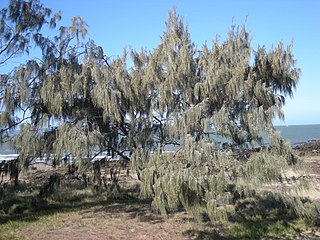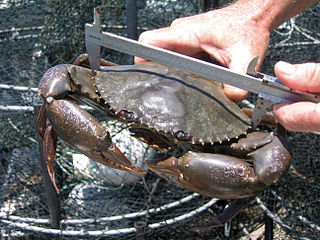
The Great Australian Bight is a large oceanic bight, or open bay, off the central and western portions of the southern coastline of mainland Australia.

The Coral Sea is a marginal sea of the South Pacific off the northeast coast of Australia, and classified as an interim Australian bioregion. The Coral Sea extends 2,000 kilometres (1,200 mi) down the Australian northeast coast.
The halfbeaks, also called spipe fish or spipefish are a geographically widespread and numerically abundant family of epipelagic fish inhabiting warm waters around the world. The halfbeaks are named for their distinctive jaws, in which the lower jaws are significantly longer than the upper jaws. The similar viviparous halfbeaks have often been included in this family.

Ostracods, or ostracodes, are a class of the Crustacea, sometimes known as seed shrimp. Some 70,000 species have been identified, grouped into several orders. They are small crustaceans, typically around 1 mm (0.039 in) in size, but varying from 0.2 to 30 mm in the case of Gigantocypris. Their bodies are flattened from side to side and protected by a bivalve-like, chitinous or calcareous valve or "shell". The hinge of the two valves is in the upper (dorsal) region of the body. Ostracods are grouped together based on gross morphology. While early work indicated the group may not be monophyletic; and early molecular phylogeny was ambiguous on this front, recent combined analyses of molecular and morphological data found support for monophyly in analyses with broadest taxon sampling

Casuarina equisetifolia, or Australian pine tree, is a she-oak species of the genus Casuarina. The native range extends from Thailand, Burma and Vietnam throughout Malaysia east to French Polynesia, New Caledonia, and Vanuatu, and south to Australia and is also found in Brunei. Populations are also found in Madagascar, but it is doubtful if this is within the native range of the species. The species has been introduced to the Southern United States and West Africa. It is an invasive species in Florida, South Africa and Brazil

Scylla serrata is an ecologically important species of crab found in the estuaries and mangroves of Africa, Australia and Asia. In their most common form, the shell colour varies from a deep, mottled green to very dark brown.

Calanoida is an order of copepods, a kind of zooplankton. They include around 46 families with about 1800 species of both marine and freshwater copepods. Calanoid copepods are dominant in the plankton in many parts of the world's oceans, making up 55%–95% of plankton samples. They are therefore important in many food webs, taking in energy from phytoplankton and algae and 'repackaging' it for consumption by higher trophic level predators. Many commercial fish are dependent on calanoid copepods for diet in either their larval or adult forms. Baleen whales such as bowhead whales, sei whales, right whales and fin whales eat calanoid copepods.

Melo miltonis, the southern bailer or southern baler, is a large sea snail, a marine gastropod mollusc in the family Volutidae, the volutes.

Zalipais is a genus of minute sea snails or micromollusks, marine gastropod molluscs in the family Skeneidae.
Zalipais benthicola is a species of minute sea snail, a marine gastropod mollusc in the family Skeneidae.
Zalipais lissa is a species of minute sea snail, a marine gastropod mollusc in the family Skeneidae.
Zalipais parva is a species of minute sea snail, a marine gastropod mollusc in the family Skeneidae.

The Mediterranean mussel is a species of bivalve, a marine mollusc in the family Mytilidae. It is an invasive species in many parts of the world, and also an object of aquaculture.

Turbo exquisitus, common name the exquisite turban, is a species of sea snail, marine gastropod mollusk in the family Turbinidae.
Hypothalassia acerba is a large crab found in the muddy substrates of the deep seas off the southwestern Australian and New Zealand coasts. Australian distribution, which is correlated to depth and temperature, ranges from a latitude as far north as approximately 27° S on the west coast, southwards, then eastwards on the south coast to a longitude of at least 129° E. The species usually occurs in waters with temperatures of 13–19 °C (55–66 °F) and in depths ranging of 200–255 metres (656–837 ft) on the lower west coast and 90–200 m (300–660 ft) on the south coast. Body size is inversely related to depth of water. There are only two species in the genus Hypothalassia, and H. acerba is not the same champagne crab as the other Hypothalassia species, H. armata, which is found in Japanese waters.
Verconia haliclona is a species of colourful sea slug, a dorid nudibranch, a shell-less marine gastropod mollusk in the family Chromodorididae.
Gabrielona nepeanensis is a species of small sea snail with calcareous opercula, a marine gastropod mollusk in the family Phasianellidae, the pheasant snails.
Anatoma australis, common name the southern slit shell, is a species of minute sea snail, a marine gastropod mollusk or micromollusk in the family Anatomidae.
Scissurella ornata, common name the ornate slit shell, is a species of minute sea snail, a marine gastropod mollusk or micromollusk in the family Scissurellidae, the little slit snails.

Zalipais inscripta is a species of minute sea snail, a marine gastropod mollusc in the family Skeneidae.













